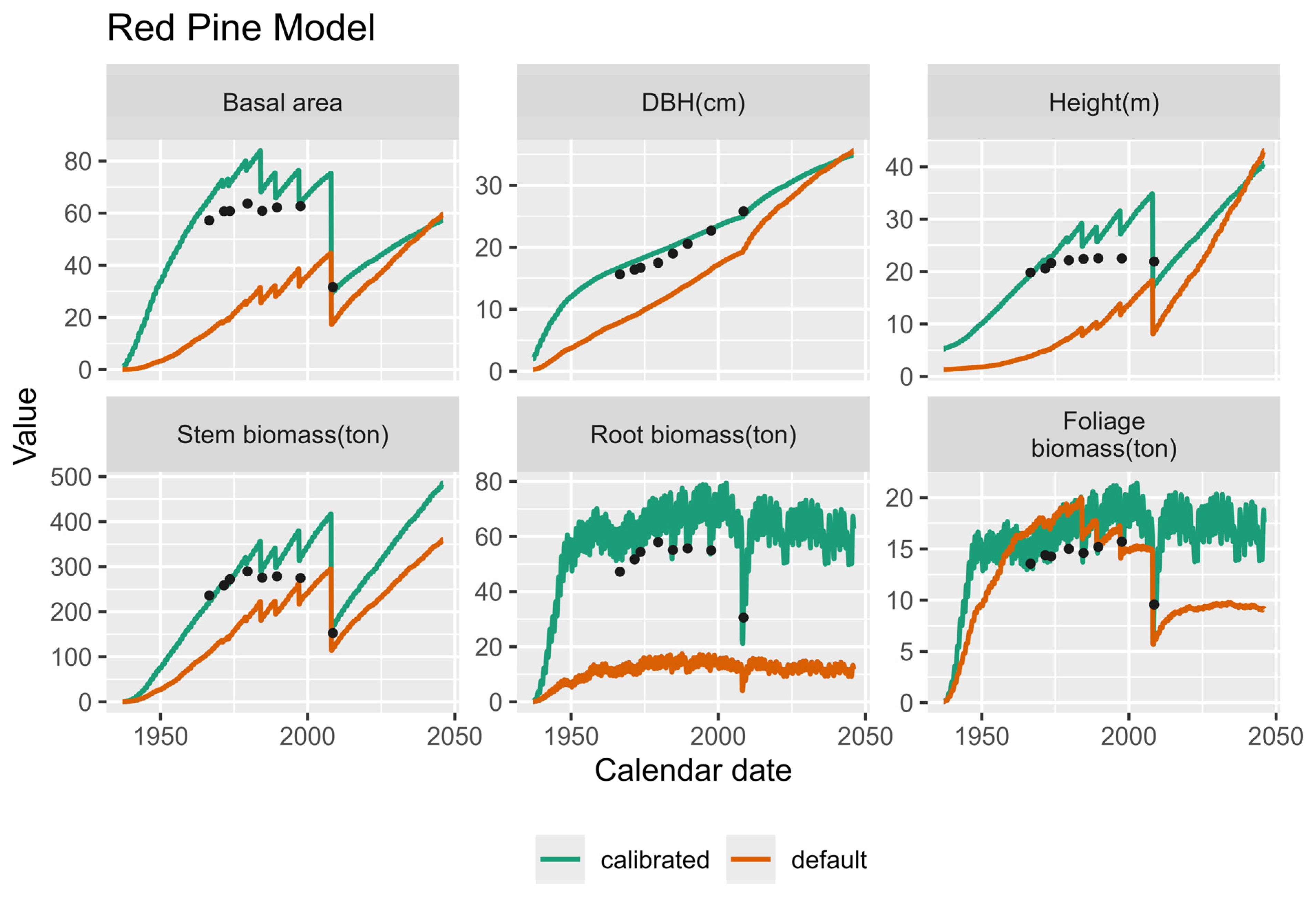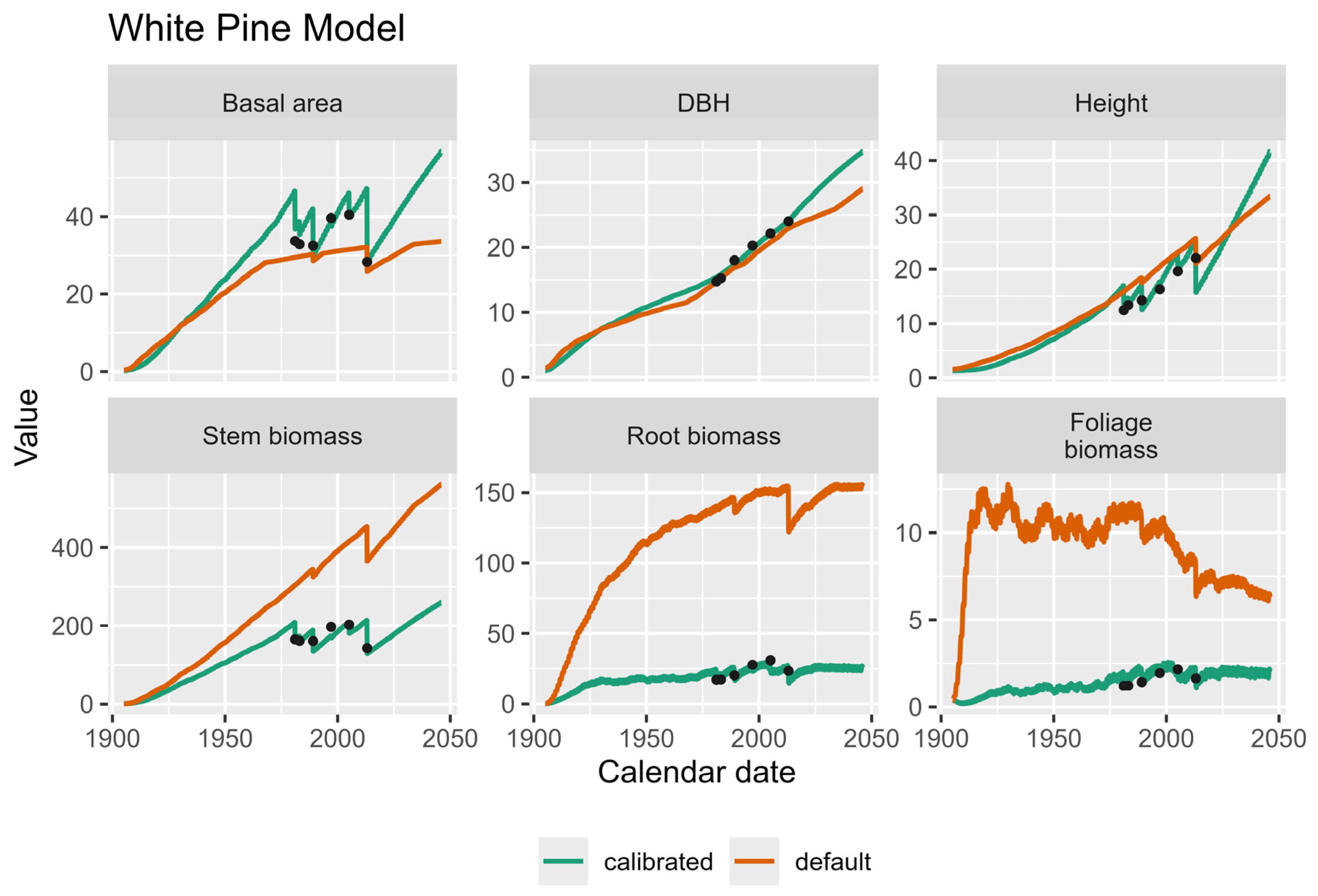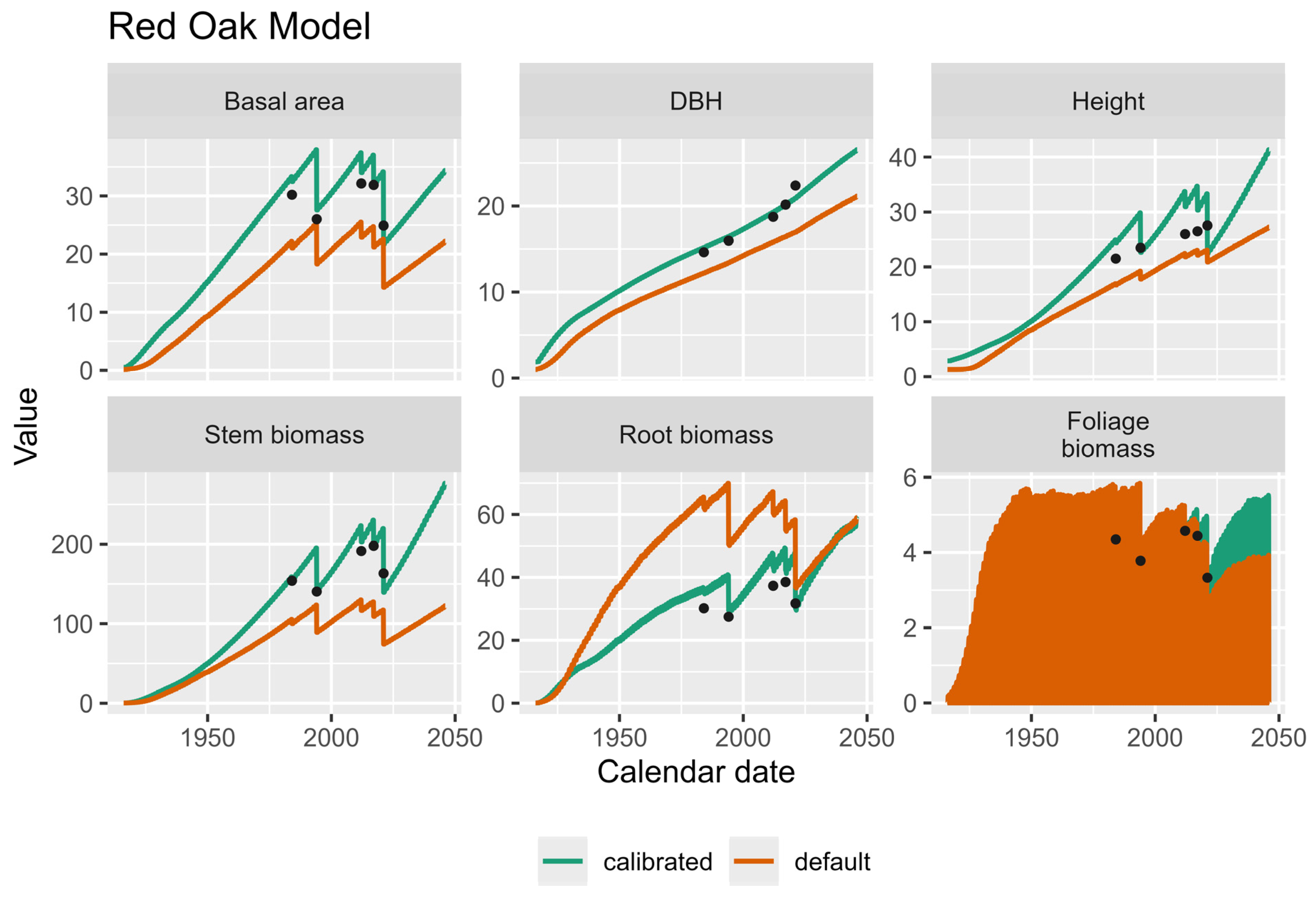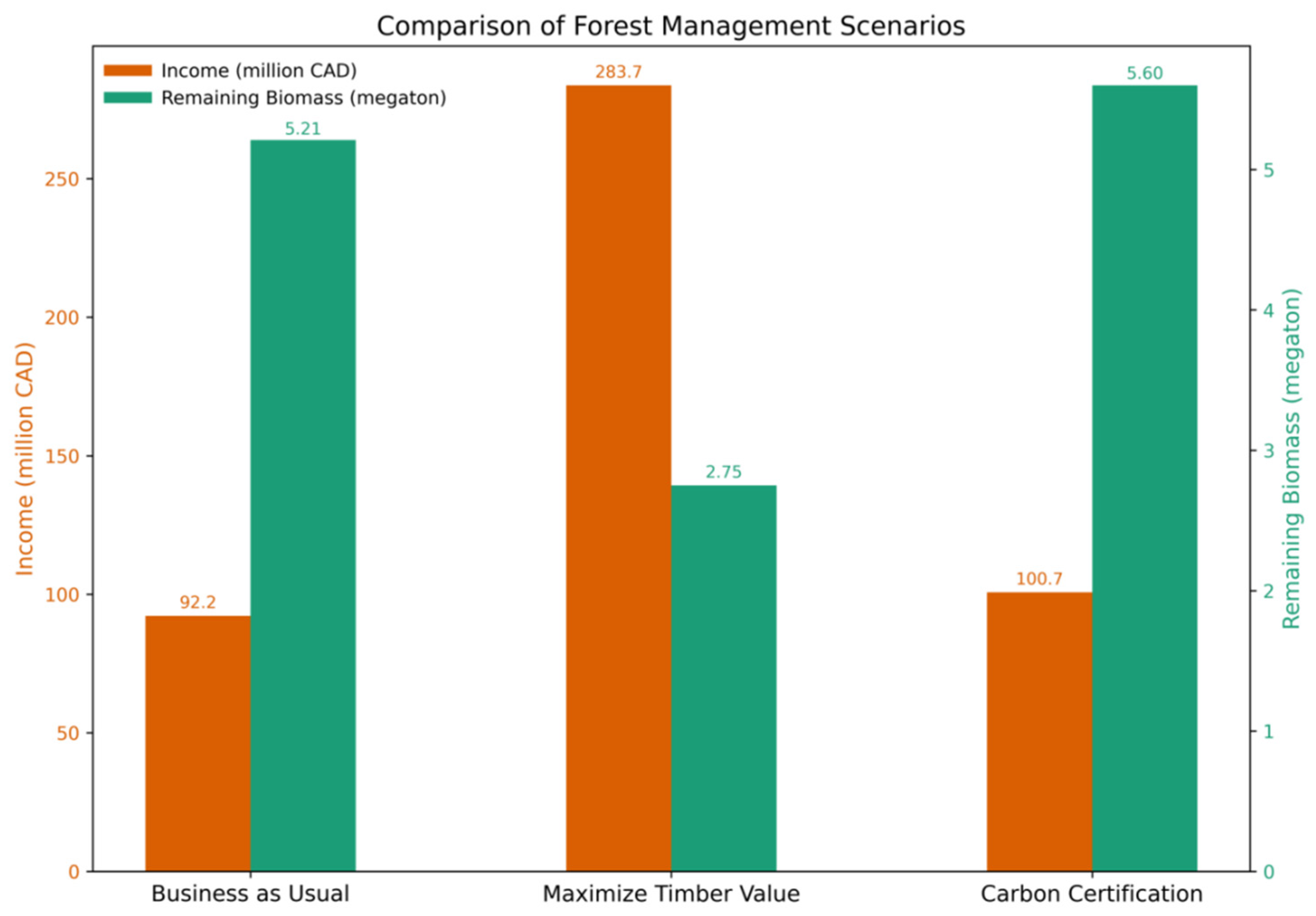Modeling Carbon Sequestration and Economic Returns Using 3-PG in the FSC-Certified Simcoe County Forest
Abstract
1. Introduction
2. Materials and Method
2.1. Study Area
2.2. Dataset
2.3. Calibration and Validation
2.4. Maximize Economic Values
2.5. Carbon Certification
3. Result
3.1. Model Outputs
3.2. Calibration and Validation Errors
3.3. Three Scenarios
4. Discussion and Recommendation
4.1. 3-PG Parameters Rationality
4.2. Trade-Off Between Economic Returns and Carbon Sequestration
4.3. Limitations
4.4. Future Research
5. Conclusions
Supplementary Materials
Author Contributions
Funding
Data Availability Statement
Acknowledgments
Conflicts of Interest
References
- De Meyer, F.; Jouenne, S. Industrial carbon capture by absorption: Recent advances and path forward. Curr. Opin. Chem. Eng. 2022, 38, 100868. [Google Scholar] [CrossRef]
- Olabi, A.G.; Wilberforce, T.; Elsaid, K.; Sayed, E.T.; Maghrabie, H.M.; Abdelkareem, M.A. Large scale application of carbon capture to process industries—A review. J. Clean. Prod. 2022, 362, 132300. [Google Scholar] [CrossRef]
- Greenhouse Gas Emissions: Quantification, Reporting and Verification, Ontario Regulation 390/18. 2018. Available online: https://canlii.ca/t/56fnz (accessed on 29 September 2024).
- Paul, C.; Bartkowski, B.; Dönmez, C.; Don, A.; Mayer, S.; Steffens, M.; Weigl, S.; Wiesmeier, M.; Wolf, A.; Helming, K. Carbon farming: Are soil carbon certificates a suitable tool for climate change mitigation? J. Environ. Manag. 2023, 330, 117142. [Google Scholar] [CrossRef]
- Peterson St-Laurent, G.; Hagerman, S.; Hoberg, G. Emergence and influence of a new policy regime: The case of forest carbon offsets in British Columbia. Land Use Policy 2017, 60, 169–180. [Google Scholar] [CrossRef]
- Biggs, J.; Laaksonen-Craig, S. Viability of carbon offset-generating afforestation projects in boreal Ontario. For. Chron. 2006, 82, 70–76. [Google Scholar] [CrossRef]
- Daniels, T.L. Integrating forest carbon sequestration into a cap-and-trade program to reduce net CO2 emissions. J. Am. Plann. Assoc. 2010, 76, 463–475. [Google Scholar] [CrossRef]
- Lorenz, K.; Lal, R. Carbon Sequestration in Forest Ecosystems: The Natural Dynamic of Carbon in Forest Ecosystems; Springer Science + Business Media: Dordrecht, The Netherlands, 2010. [Google Scholar]
- Galinato, G.I.; Olanie, A.; Uchida, S.; Yoder, J.K. Long-term versus temporary certified emission reductions in forest carbon sequestration programs. Aust. J. Agric. Resour. Econ. 2011, 55, 537–559. [Google Scholar] [CrossRef]
- Aldy, J.E.; Stavins, R.N. The promise and problems of pricing carbon. J. Environ. Dev. 2012, 21, 152–180. [Google Scholar] [CrossRef]
- Ji, C.J.; Hu, Y.J.; Tang, B.J. Research on carbon market price mechanism and influencing factors: A literature review. Nat. Hazards 2018, 92, 761–782. [Google Scholar] [CrossRef]
- Zhang, W.; Li, J.; Li, G.; Guo, S. Emission reduction effect and carbon market efficiency of carbon emissions trading policy in China. Energy 2020, 196, 117117. [Google Scholar] [CrossRef]
- Environment and Natural Resources Canada. The Federal Carbon Pollution Pricing Benchmark. 2023. Available online: https://www.canada.ca/en/environment-climate-change/services/managing-pollution/energy-production/fuel-regulations/clean-fuel-regulations.html (accessed on 11 September 2024).
- Blyth, W.; Bunn, D.; Kettunen, J.; Wilson, T. Policy interactions, risk and price formation in carbon markets. Energ. Policy 2009, 37, 5192–5207. [Google Scholar] [CrossRef]
- Hintermann, B. Allowance price drivers in the first phase of the EU ETS. J. Environ. Econ. Manag. 2010, 59, 43–56. [Google Scholar] [CrossRef]
- Lederer, M. Market making via regulation: The role of the state in carbon markets. Regul. Gov. 2012, 6, 524–544. [Google Scholar] [CrossRef]
- Kreibich, N.; Hermwille, L. Caught in between: Credibility and feasibility of the voluntary carbon market post-2020. Clim. Policy 2021, 21, 939–957. [Google Scholar] [CrossRef]
- Benítez, P.C.; McCallum, I.; Obersteiner, M.; Yamagata, Y. Global potential for carbon sequestration: Geographical distribution, country risk and policy implications. Ecol. Econ. 2007, 60, 572–583. [Google Scholar] [CrossRef]
- Swallow, B.M.; Goddard, T.W. Developing Alberta’s greenhouse gas offset system within Canadian and international policy contexts. Int. J. Clim. Change Strateg. Manag. 2016, 8, 318–337. [Google Scholar] [CrossRef]
- Brisson, J.; Dreibelbis, M.; Robinson, A. Canada Launches Its First Federal Greenhouse Gas Offset Credit System. Environment, Land & Resources. 2022. Available online: https://www.globalelr.com/2022/07/canada-launches-its-first-federal-greenhouse-gas-offset-credit-system/ (accessed on 21 August 2024).
- Environment and Climate Change Canada. 2024. Available online: https://www.canada.ca/en/environment-climate-change.html (accessed on 11 September 2024).
- Raihan, A.; Begum, R.A.; Mohd Said, M.N.; Abdullah, S.M.S. A review of emission reduction potential and cost savings through forest carbon sequestration. Asian J. Water Environ. Pollut. 2019, 16, 1–7. [Google Scholar] [CrossRef]
- Legislative Services. Consolidated Federal Laws of Canada, Greenhouse Gas Pollution Pricing Act. 2024. Available online: https://laws-lois.justice.gc.ca/eng/acts/g-11.55/ (accessed on 9 October 2024).
- Roy, A.; Bhan, M. Carbon Market Initiatives for Forests in India. India Water Portal. 2024. Available online: https://www.indiawaterportal.org/articles/carbon-market-initiatives-forests-india (accessed on 23 August 2024).
- Galinato, G.I.; Uchida, S. The effect of temporary certified emission reductions on forest rotations and carbon supply. Can. J. Agric. Econ. 2010, 59, 145–164. [Google Scholar] [CrossRef]
- Phelan, L.; Henderson-Sellers, A.; Taplin, R. Climate change, carbon prices and insurance systems. Int. J. Sustain. Dev. World Ecol. 2010, 17, 95–108. [Google Scholar] [CrossRef]
- Li, L.; Ye, F.; Li, Y.; Chang, C.T. How will the Chinese certified emission reduction scheme save cost for the national carbon trading system? J. Environ. Manag. 2019, 244, 99–109. [Google Scholar] [CrossRef] [PubMed]
- Overdevest, C.; Rickenbach, M.G. Forest certification and institutional governance: An empirical study of forest stewardship council certificate holders in the United States. For. Policy Econ. 2006, 9, 93–102. [Google Scholar] [CrossRef]
- Moore, S.E.; Cubbage, F.; Eicheldinger, C. Impacts of forest stewardship council (FSC) and sustainable forestry initiative (SFI) forest certification in North America. J. For. 2012, 110, 79–88. [Google Scholar] [CrossRef]
- Simcoe County Forest. Simcoe County Forest 2011–2030 Revised 2023; Simcoe County Forest: Toronto, ON, Canada, 2023. [Google Scholar]
- Puric-Mladenovic, D.; Gleeson, J.; Nielsen, G. Estimating Carbon Storage in Southern Ontario Forests at Regional and Stand Levels; Ontario Ministry of Natural Resources and Forestry: Toronto, ON, Canada, 2016. [Google Scholar]
- Landsberg, J.J.; Waring, R.H. A generalised model of forest productivity using simplified concepts of radiation-use efficiency, carbon balance and partitioning. For. Ecol. Manag. 1997, 95, 209–228. [Google Scholar] [CrossRef]
- Landsberg, J.J.; Waring, R.H.; Coops, N.C. Performance of the forest productivity model 3-PG applied to a wide range of forest types. For. Ecol. Manag. 2003, 172, 199–214. [Google Scholar] [CrossRef]
- Bai, Y.; Pang, Y.; Kong, D. Integrating remote sensing and 3-PG model to simulate the biomass and carbon stock of Larix olgensis plantation. For. Ecosyst. 2024, 11, 100213. [Google Scholar] [CrossRef]
- Forrester, D.I.; Tang, X. Analysing the spatial and temporal dynamics of species interactions in mixed-species forests and the effects of stand density using the 3-PG model. Ecol. Model. 2016, 319, 233–254. [Google Scholar] [CrossRef]
- Forrester, D.I.; Ammer, C.H.; Annighöfer, P.J.; Avdagic, A.; Barbeito, I.; Bielak, K.; Brazaitis, G.; Coll, L.; Del Río, M.; Drössler, L.; et al. Predicting the spatial and temporal dynamics of species interactions in Fagus sylvatica and Pinus sylvestris forests across Europe. For. Ecol. Manag. 2017, 405, 112–133. [Google Scholar] [CrossRef]
- Gupta, R.; Sharma, L.K. The process-based forest growth model 3-PG for use in forest management: A review. Ecol. Model. 2019, 397, 55–73. [Google Scholar] [CrossRef]
- Lin, S.; He, Z.; Huang, H.; Chen, L.; Li, L. Mixed forest specific calibration of the 3-pgmix model parameters from site observations to predict post-fire forest regrowth. For. Ecol. Manag. 2022, 515, 120208. [Google Scholar] [CrossRef]
- Vega-Nieva, D.J.; Tomé, M.; Tomé, J.; Fontes, L.; Soares, P.; Ortiz, L.; Basurco, F.; Rodrígez-Soalleiro, R. Developing a general method for the estimation of the fertility rating parameter of the 3-PG model: Application in Eucalyptus globulus plantations in northwestern Spain. Can. J. For. Res. 2013, 43, 627–636. [Google Scholar] [CrossRef]
- Augustynczik, A.L.D.; Hartig, F.; Minunno, F.; Kahle, H.P.; Diaconu, D.; Hanewinkel, M.; Yousefpour, R. Productivity of Fagus sylvatica under climate change—A Bayesian analysis of risk and uncertainty using the model 3-PG. For. Ecol. Manag. 2017, 401, 192–206. [Google Scholar] [CrossRef]
- Trotsiuk, V.; Hartig, F.; Forrester, D.I. R3PG—An R package for simulating forest growth using the 3-PG process-based model. Methods Ecol. Evol. 2020, 11, 1470–1475. [Google Scholar] [CrossRef]
- Lessa Derci Augustynczik, A.; Yousefpour, R. Assessing the synergistic value of ecosystem services in European beech forests. Ecosyst. Serv. 2021, 49, 101264. [Google Scholar] [CrossRef]
- Palma, J.H.; Hakamada, R.; Moreira, G.G.; Nobre, S.; Rodriguez, L.C.E. Using 3PG to assess climate change impacts on management plan optimization of Eucalyptus plantations. A case study in southern Brazil. Sci. Rep. 2021, 11, 2708. [Google Scholar] [CrossRef]
- Tomback, D.F.; Achuff, P. Blister rust and western forest biodiversity: Ecology, values and outlook for white pines. For. Pathol. 2010, 40, 186–225. [Google Scholar] [CrossRef]
- Anand, M.; Leithead, M.; Silva, L.C.; Wagner, C.; Ashiq, M.W.; Cecile, J.; Drobyshev, I.; Bergeron, Y.; Das, A.; Bulger, C. The scientific value of the largest remaining old-growth red pine forests in North America. Biodivers. Conserv. 2013, 22, 1847–1861. [Google Scholar] [CrossRef]
- UBC Forestry. 3PG Course: Lectures: 3-PG Forest Growth Model. 2020. Available online: https://3pg.forestry.ubc.ca/3-pg-course/ (accessed on 19 May 2024).
- Agriculture and Agri-Food Canada. Soil Survey of Simcoe County. 2024. Available online: https://sis.agr.gc.ca/cansis/publications/surveys/on/on29/index.html (accessed on 24 September 2024).
- Alban, D.H.; Laidly, P.R. Generalized biomass equations for Jack and red pine in the Lake States. Can. J. For. Res. 1982, 12, 913–921. [Google Scholar] [CrossRef]
- Peichl, M.; Arain, M.A. Allometry and partitioning of above- and belowground tree biomass in an age-sequence of white pine forests. For. Ecol. Manag. 2007, 253, 68–80. [Google Scholar] [CrossRef]
- Chapman, J.W.; Gower, S.T. Aboveground production and canopy dynamics in sugar maple and red oak trees in southwestern Wisconsin. Can. J. For. Res. 1991, 21, 1533–1543. [Google Scholar] [CrossRef]
- Ouimet, R.; Camiré, C.; Brazeau, M.; Moore, J.D. Estimation of coarse root biomass and nutrient content for sugar maple, Jack Pine, and black spruce using stem diameter at breast height. Can. J. For. Res. 2008, 38, 92–100. [Google Scholar] [CrossRef]
- Minunno, F.; van Oijen, M.; Cameron, D.R.; Pereira, J.S. Selecting parameters for Bayesian calibration of a process-based model: A methodology based on canonical correlation analysis. J. Uncertain. Quantif. 2013, 1, 370–385. [Google Scholar] [CrossRef][Green Version]
- Van Oijen, M.; Reyer, C.; Bohn, F.J.; Cameron, D.R.; Deckmyn, G.; Flechsig, M.; Härkönen, S.; Hartig, F.; Huth, A.; Kiviste, A.; et al. Bayesian calibration, comparison and averaging of six forest models, using data from Scots pine stands across Europe. For. Ecol. Manag. 2013, 289, 255–268. [Google Scholar] [CrossRef]
- Wang, H.; Ma, Y.; Zhou, W.; Shi, Y.; Su, X. Development of a system for simulating and visualizing the biomass of fir trees using a parameter optimized 3-PG model. In Proceedings of the Fourth International Conference on Applied Mathematics, Modelling, and Intelligent Computing (CAMMIC 2024), Kaifeng, China, 22–24 March 2024. [Google Scholar]
- Bagnara, M.; Van Oijen, M.; Cameron, D.; Gianelle, D.; Magnani, F.; Sottocornola, M. Bayesian calibration of simple forest models with multiplicative mathematical structure: A case study with two light use efficiency models in an Alpine forest. Ecol. Model. 2018, 371, 90–100. [Google Scholar] [CrossRef]
- Liu, C.; Zheng, X.; Ren, Y. Parameter optimization of the 3PG model based on sensitivity analysis and a Bayesian method. Forests 2020, 11, 1369. [Google Scholar] [CrossRef]
- Forrester, D.I.; Hobi, M.L.; Mathys, A.S.; Stadelmann, G.; Trotsiuk, V. Calibration of the process-based model 3-PG for major Central European tree species. Eur. J. For. Res. 2021, 140, 847–868. [Google Scholar] [CrossRef]
- Sauter, P.A.; Mußhoff, O. What is your discount rate? Experimental evidence of foresters’ risk and time preferences. Ann. For. Sci. 2018, 75, 10. [Google Scholar] [CrossRef]
- Matweb. The Online Materials Information Resource. 1999. Available online: https://www.matweb.com/search/search.aspx (accessed on 16 July 2024).
- Santantonio, D.; Hermann, R.K.; Overton, W.S. Root biomass studies in forest ecosystems. Pedobiologia 1977, 17, 1–31. [Google Scholar] [CrossRef]
- Wood Database. Eastern White Pine. 2017. Available online: https://www.wood-database.com/eastern-white-pine/ (accessed on 29 May 2024).
- Wood Database. Red Oak. 2022. Available online: https://www.wood-database.com/red-oak/ (accessed on 29 May 2024).
- Grafton, R.Q.; Chu, H.L.; Nelson, H.; Bonnis, G. A global analysis of the cost-efficiency of forest carbon sequestration. OECD Environ. Work. Pap. 2021, 17, 1–66. [Google Scholar]
- CSIMarket. Forestry & Wood Products Industry Profitability. 2025. Available online: https://csimarket.com/Industry/industry_Profitability_Ratios.php?hist=1&ind=105&utm (accessed on 1 October 2024).
- Amichev, B.Y.; Hangs, R.D.; Van Rees, K.C.J. A novel approach to simulate growth of multi-stem willow in bioenergy production systems with a simple process-based model (3PG). Biomass Bioenerg. 2011, 35, 473–488. [Google Scholar] [CrossRef]
- Wei, L.; Marshall, J.D.; Zhang, J.; Zhou, H.; Powers, R.F. 3-PG simulations of young ponderosa pine plantations under varied management intensity: Why do they grow so differently? For. Ecol. Manag. 2014, 313, 69–82. [Google Scholar] [CrossRef]
- Kuuluvainen, T.; Lindberg, H.; Vanha-Majamaa, I.; Keto-Tokoi, P.; Punttila, P. Low-level retention forestry, certification, and biodiversity: Case Finland. Ecol. Process. 2019, 8, 47. [Google Scholar] [CrossRef]
- Großmann, J.; Carlson, L.; Kändler, G.; Pyttel, P.; Kleinschmit, J.R.; Bauhus, J. Evaluating retention forestry 10 years after its introduction in temperate forests regarding the provision of tree-related microhabitats and dead wood. Eur. J. For. Res. 2023, 142, 1125–1147. [Google Scholar] [CrossRef]
- Peng, C. Understanding the role of forest simulation models in sustainable forest management. Environ. Impact Assess. Rev. 2000, 20, 481–501. [Google Scholar] [CrossRef]
- Rist, L.; Moen, J. Sustainability in forest management and a new role for resilience thinking. For. Ecol. Manag. 2013, 310, 416–427. [Google Scholar] [CrossRef]
- Kant, S. Economics of sustainable forest management. For. Policy Econ. 2004, 6, 197–203. [Google Scholar] [CrossRef] [PubMed]
- Chazdon, R.L.; Lindenmayer, D.; Guariguata, M.R.; Crouzeilles, R.; Benayas, J.M.R.; Chavero, E.L. Fostering natural forest regeneration on former agricultural land through economic and policy interventions. Environ. Res. Lett. 2020, 15, 099501. [Google Scholar] [CrossRef]
- Li, R.; Yan, Q.; Xie, J.; Wang, J.; Zhang, T.; Zhu, J. Effects of logging on the trade-off between seed and sprout regeneration of dominant woody species in secondary forests of the Natural Forest Protection Project of China. Ecol. Process. 2022, 11, 16. [Google Scholar] [CrossRef]
- Payne, N.J.; Cameron, D.A.; Leblanc, J.D.; Morrison, I. Carbon storage and net primary productivity in Canadian boreal mixedwood stands. J. For. Res. 2019, 30, 1667–1678. [Google Scholar] [CrossRef]
- Foley, T.G.; Richter, D.D.; Galik, C.S. Extending rotation age for carbon sequestration: A cross-protocol comparison of North American forest offsets. For. Ecol. Manag. 2009, 259, 201–209. [Google Scholar] [CrossRef]
- Yemshanov, D.; Mckenney, D.; Fraleigh, S.; D’eon, S. An integrated spatial assessment of the investment potential of three species in southern Ontario, Canada inclusive of carbon benefits. For. Policy Econ. 2004, 10, 48–59. [Google Scholar] [CrossRef]
- Guo, J.; Gong, P. The potential and cost of increasing forest carbon sequestration in Sweden. J. For. Econ. 2017, 29, 78–86. [Google Scholar] [CrossRef]
- López-Serrano, F.R.; Martínez-García, E.; Dadi, T.; Rubio, E.; García-Morote, F.A.; Lucas-Borja, M.E.; Andrés-Abellán, M. Biomass growth simulations in a natural mixed forest stand under different thinning intensities by 3-PG process-based model. Eur. J. For. Res. 2014, 134, 167–185. [Google Scholar] [CrossRef]
- Bouwman, M.; Forrester, D.I.; den Ouden, J.; Nabuurs, G.J.; Mohren, G.M.J. Species interactions under climate change in mixed stands of Scots pine and pedunculate oak. For. Ecol. Manag. 2021, 481, 118615. [Google Scholar] [CrossRef]
- Roberge, J.M.; Laudon, H.; Björkman, C.; Ranius, T.; Sandström, C.; Felton, A.; Sténs, A.; Nordin, A.; Granström, A.; Widemo, F.; et al. Socio-ecological implications of modifying rotation lengths in forestry. Ambio 2016, 45, 109–123. [Google Scholar] [CrossRef] [PubMed]
- Nakajima, T.; Shiraishi, N.; Kanomata, H.; Matsumoto, M. A method to maximise forest profitability through optimal rotation period selection under various economic, site and silvicultural conditions. N. Z. J. For. Sci. 2017, 47, 4. [Google Scholar] [CrossRef]
- VCS Program Fee. Program Fee Schedule V4.3 Final. 2024. Available online: https://www.scribd.com/document/660303304/Program-Fee-Schedule-v4-3-FINAL (accessed on 25 July 2024).






| Red Pine | Sugar Maple | White Pine | Red Oak | |||||
|---|---|---|---|---|---|---|---|---|
| Calibration | Validation | Calibration | Validation | Calibration | Validation | Calibration | Validation | |
| e_percent_stem | 5.42 | 0.29 | 0.99 | 4.96 | −6.8 | −6.37 | −0.74 | 7.71 |
| MAE_percent_stem | 7.14 | 4.72 | 3.26 | 5.34 | 6.8 | 6.55 | 4.03 | 8.28 |
| MSE_stem | 489.36 | 306.30 | 111.75 | 344.44 | 201.73 | 123.98 | 108.72 | 559.22 |
| e_percent_root | 4.63 | 2.58 | −14.05 | −17.64 | −8.04 | −0.97 | 7.97 | 0.82 |
| MAE_percent_root | 4.63 | 6.95 | 14.05 | 17.64 | 11.54 | 6.38 | 7.98 | 7.00 |
| MSE_root | 8.50 | 29.67 | 44.32 | 86.45 | 12.67 | 5.96 | 10.31 | 9.39 |
| e_percent_foliage | 2.45 | −7.82 | 13.86 | 9.81 | 3.06 | 10.13 | −6.20 | 6.12 |
| MAE_percent_foliage | 2.67 | 8.06 | 14.3 | 10.64 | 9.80 | 11.69 | 6.60 | 6.37 |
| MSE_foliage | 0.17 | 4.19 | 1.81 | 1.10 | 0.03 | 0.06 | 0.16 | 0.11 |
| R square | 0.79 | 0.94 | 0.96 | 0.93 | 0.65 | 0.78 | 0.80 | 0.69 |
Disclaimer/Publisher’s Note: The statements, opinions and data contained in all publications are solely those of the individual author(s) and contributor(s) and not of MDPI and/or the editor(s). MDPI and/or the editor(s) disclaim responsibility for any injury to people or property resulting from any ideas, methods, instructions or products referred to in the content. |
© 2025 by the authors. Licensee MDPI, Basel, Switzerland. This article is an open access article distributed under the terms and conditions of the Creative Commons Attribution (CC BY) license (https://creativecommons.org/licenses/by/4.0/).
Share and Cite
Sun, F.; Yousefpour, R. Modeling Carbon Sequestration and Economic Returns Using 3-PG in the FSC-Certified Simcoe County Forest. Forests 2025, 16, 1610. https://doi.org/10.3390/f16101610
Sun F, Yousefpour R. Modeling Carbon Sequestration and Economic Returns Using 3-PG in the FSC-Certified Simcoe County Forest. Forests. 2025; 16(10):1610. https://doi.org/10.3390/f16101610
Chicago/Turabian StyleSun, Fanxuan, and Rasoul Yousefpour. 2025. "Modeling Carbon Sequestration and Economic Returns Using 3-PG in the FSC-Certified Simcoe County Forest" Forests 16, no. 10: 1610. https://doi.org/10.3390/f16101610
APA StyleSun, F., & Yousefpour, R. (2025). Modeling Carbon Sequestration and Economic Returns Using 3-PG in the FSC-Certified Simcoe County Forest. Forests, 16(10), 1610. https://doi.org/10.3390/f16101610







